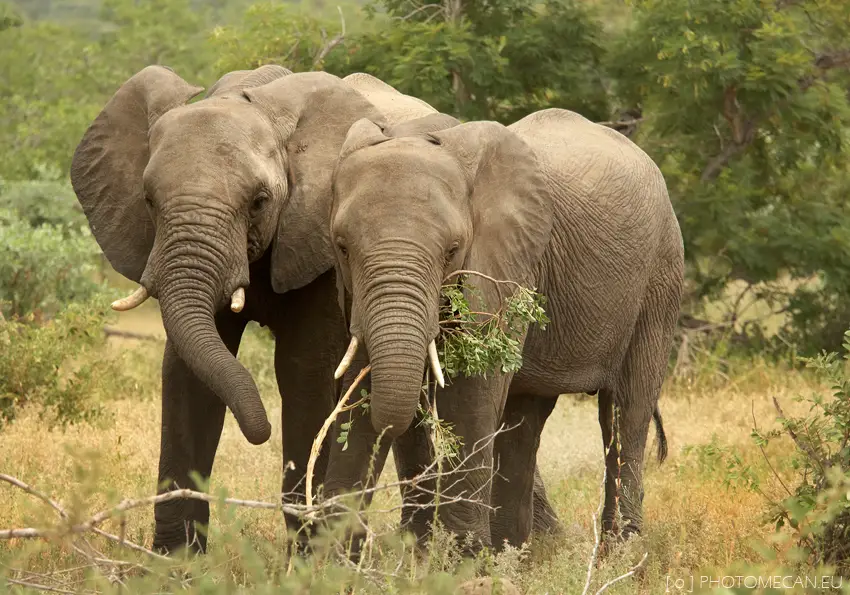The African bush elephant (Loxodonta africana) is the largest of all elephants. It stands almost four meters in height and it is the heaviest living elephant species. African bush elephant and the African forest elephant have long been treated as a single species but the recent study shows that they both are distinct species. Out of four subspecies one is thought to go extinct in the wild. The extinct species is the Northern African bush elephant.
African Bush Elephant Facts
Anatomy
- The maximum shoulder height of the largest elephant measured about 3.96 m (13.0 ft). This is the measurement of the largest specimen ever recorded. Sadly enough the elephant was shot in 1974.
- On average adult male stands 3.3 meters (10.8 ft) at the shoulder and weigh as much as 5.5 tones (12,130 lb) making it the world’s largest living land mammal. Females on the other hand average 2.8 meters (9.2 ft) at the shoulder height with the weight averaging 3.7 tones (8,160 lb).
- The elephant’s trunk mainly serves as a tool that helps to communicate as well as to life heavy objects along the way.
- They are more likely to possess larger tusks than Asian elephants. The African elephant’s incisors grow about 7 inches per year and it continues to grow all its life.
- Both male and female display incisors as these are typically used either for fighting or marking or simply for digging and feeding.
See also: Elephant Facts For Kids

Habitat
- The African bush elephant is thought to occur in a wide variety of habitats such as grasslands, primary forests, and partial deserts. They prefer to live here because all these habitats offer shrubbery leaves and trees or herbs.
Read More: Where Do African Elephants Live?
Feeding Ecology & Diet
- They are herbivorous mammals and as such their diet typically consists of plants, trees or herbs. Some of the elephant populations especially those found in Lake Kariba are likely to rely on underwater plants.
- With the help of its 30-cm long molars African bush elephants can easily break down the plants. All these molars are replaced with the new ones that grow in time.
- Each day they consume as much as 225 kilograms (500 lb) of vegetables. It provides great energy to the elephants because they have to travel miles daily searching food or even water.
- They might knock down large trees should they really want to enjoy leaves from the top.
- Elephants must not go far away from water sources because they need to drink 190 liters of water per day.
See also:What Do African Elephants Eat in the Wild?
Behavior
- Like typical elephants, adult bush elephants fancy living solitary lives except during the breeding season.
- They do form herds which mainly consist almost entirely of females and young. The herd is led by a dominated female known as ‘matriarch’. The herds break away soon after the young reaches adulthood. It will then search a female for mating.
- Nevertheless, elephants do recognize their parents or relatives whenever they find opportunity to meet again. This is quite unique among large mammals. As it turns out, the herds sometimes go hundreds in number when the older elephants rejoin them.
- The leader of the herd is supposed to show the route to all the group members. She will also guide them to the water source so that later when they need to drink they must be able to find one on their own.
- There seems to be a strong bond between members of the same herd. When a female gives birth, the other members appreciate her by touching her with trunks. Similarly if one of them dies all the rest mourns her death by standing on it for a while. It is not wrong to assume that elephants do feel for each other.
Read More: African Bush Elephant Habitat

Reproductive Biology
- The mating season is not fixed in African bush elephants as they mate anytime (but not every time) during the year.
- The female begins to produce infrasounds to call for her mating partner. This shows the willingness on the part of a female.
- African elephants have gestation period of 22 months.
- One young is mostly born that weighs up to 100 kg at birth. The calf is 90 cm tall.
- In the first five years the calf relies on its mother for feeding. It may eat solid food once it attains 180 days age.
- The average lifespan of African bush elephants is 65 – 70 years in the wild. In captivity one specimen believed to live up to 80 years.
- Predators of African bush elephant’s calves are lions, hyenas, leopards, and crocodiles.
Conservation Status
Vulnerable






Leave a Reply